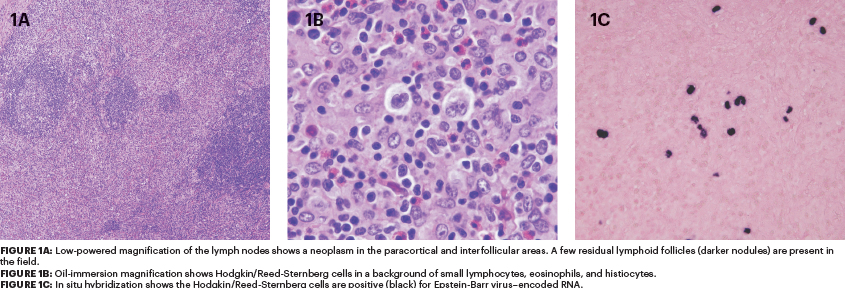Question 1
Which of the following statements about mixed-cellularity classic Hodgkin lymphoma is correct?
A. It has a female predominance.
B. This type of classic Hodgkin lymphoma is relatively more common in developing nations and is frequently associated with Epstein-Barr virus (EBV) positivity.
C. It is usually not observed in patients with HIV infection.
D. It accounts for approximately 70% of classic Hodgkin lymphomas.
Question 2
Which of the following statements about morphology in mixed-cellularity classic Hodgkin lymphoma is correct?
A. This type of classic Hodgkin lymphoma is characterized by Hodgkin/Reed-Sternberg (HRS) cells with lacunar-type morphology.
B. The lymph node architecture is usually well preserved.
C. It is characterized by classic HRS cells in a diffuse mixed inflammatory background.
D. All of the above
Question 3
Which of the following statements about immune histology in mixed-cellularity classic Hodgkin lymphoma is correct?
A. CD30 is expressed in nearly all cases.
B. CD15 is expressed in 75% to 85% of cases.
C. EBV-encoded small RNA are expressed much more frequently in this subtype of classic Hodgkin lymphoma.
D. All of the above
Answers to Hematology Expert Review Questions
Question 1
Which of the following statements about mixed-cellularity classic Hodgkin lymphoma is correct?
Correct answer: B. This type of classic Hodgkin lymphoma is relatively more common in developing nations and is frequently associated with EBV positivity.
Expert Perspective
Classic Hodgkin lymphoma is a monoclonal lymphoid neoplasm derived from B cells composed of mononuclear Hodgkin cells and multinucleated Reed-Sternberg cells in a background containing a variable mixture of non-neoplastic reactive immune cells, including small lymphocytes, eosinophils, histiocytes, and plasma cells.1,2 (For further details on the four histologic types of classic Hodgkin lymphoma, see the answer to question 1, part 1).
In the developing world, mixed-cellularity classic Hodgkin lymphoma is relatively more common (than in developed nations) and is frequently associated with EBV positivity (approximately 75% of cases). Mixed-cellularity classic Hodgkin lymphoma is more frequent in patients with HIV infection and in developing countries. The mixed-cellularity classic Hodgkin lymphoma accounts for approximately 20% to 25% of classic Hodgkin lymphomas. Nodular sclerosis classic Hodgkin lymphoma accounts for approximately 70% of all classic Hodgkin lymphomas in Europe and the United States.1,2 (For more information, see “The WHO Classification of Tumors of Hematopoietic and Lymphoid Tissues: Classic Hodgkin Lymphoma–Nodular Sclerosis Type” in the December 25, 2019, issue of The ASCO Post.) In mixed-cellularity classic Hodgkin lymphoma, peripheral lymph nodes are frequently involved, and mediastinal involvement is uncommon. The spleen is involved in 30% of cases; bone marrow, in 10%; liver, in 3% (see Table 1 for features of this type of classic Hodgkin lymphoma); and other organs, in 1% to 3%.
Question 2
Which of the following statements about morphology in mixed-cellularity classic Hodgkin lymphoma is correct?
Correct answer: C. Mixed-cellularity classic Hodgkin lymphoma is characterized by classic HRS cells in a diffuse mixed inflammatory background.

Expert Perspective
Nodular sclerosis, not mixed-cellularity, classic Hodgkin lymphoma is characterized by collagen bands that surround at least one nodule (nodular sclerosis) and by HRS cells with lacunar-type morphology.1 In mixed-cellularity classic Hodgkin lymphoma, fine interstitial fibrosis may be present, but fibrous bands are absent, and capsular fibrosis is usually absent (Figure 1A).1,2 The lymph node architecture is usually obliterated. Mixed-cellularity classic Hodgkin lymphoma is characterized by classic HRS cells in a diffuse mixed inflammatory background (Figure 1B).
Question 3
Which of the following statements about immune histology in mixed-cellularity classic Hodgkin lymphoma is correct?
Correct answer: D. All of the above.
Expert Perspective

CD30 is expressed in virtually all cases of mixed-cellularity classic Hodgkin lymphoma, but CD15 may be negative in 15% to 25% of cases (see Table 1). PAX5 is weakly positive. CD45 is negative in nearly all cases.3 CD20 may be variably expressed but is usually weak and only on a subset of the neoplastic cells (30%–40%).3 CD79a is positive in approximately 10% of cases.1,2 EBV-encoded small RNA is expressed much more frequently in this subtype of classic Hodgkin lymphoma (Figure 1C).
DISCLOSURE: Dr. Abutalib is an advisor for AstraZeneca. Dr. Medeiros reported no conflicts of interest.
REFERENCES
1. Stein H, Pileri SA, Weiss LM, et al: Hodgkin lymphomas: Introduction, in Swerdlow SH, Campo E, Harris NL, et al (eds.): WHO Classification of Tumours of Haematopoietic and Lymphoid Tissues, pp 424-430. Lyon, France, International Agency for Research in Cancer, 2017.
2. Weiss LM, Poppema S, Jaffe ES, et al: Classic Hodgkin lymphoma, in Swerdlow SH, Campo E, Harris NL, et al (eds.): WHO Classification of Tumours of Haematopoietic and Lymphoid Tissues, pp 440-442. Lyon, France, International Agency for Research in Cancer (IARC), 2017.
3. Naeim F, Rao NP, Song SX, et al: Classic Hodgkin Lymphomas, in Atlas of Hematopathology: Morphology, Immunophenotype, Cytogenetics, and Molecular Approaches, pp 601-612. New York, NY, Elsevier, 2013.



